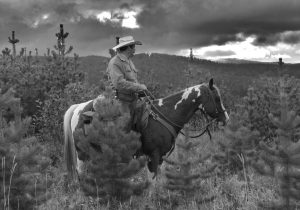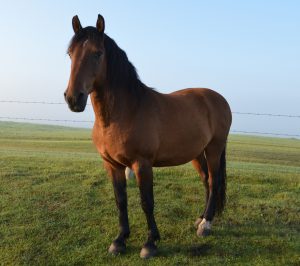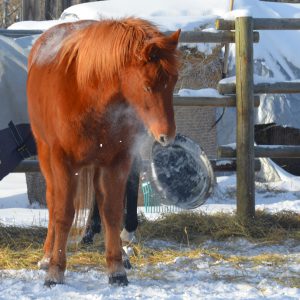Is horse sense sensible, nonsense, or common sense?
The title, Horse Sense, is admittedly of a general nature. We’re well aware of our own five senses, although we do have – and use – more. In this context though, I’ll define the word as: acute perception and observation skills.
Do horses have the ability to sense things more easily and accurately than humans, and if so, how? And better yet, can we make use of their abilities? Like the saying goes, two minds are better than one. I’d like to share some personal examples and my thoughts on what I consider an incredible asset offered you by your horse.
Lets make a fair comparison between people and horses. Horses live in the moment. They don’t make plans for the next week nor do they dwell on the past. Horses are prey animals and we are predators. Humans rely on cunning, tools, and knowledge accumulated from experience and external sources. Prey animals rely on their senses, instincts and bodies to preserve themselves. It’s essential that they possess finely honed senses and instincts. For humans…well, not always. We increasingly rely on tools: GPS in our phones to navigate, computers with internet integrated into TV’s, speakers, vehicles and even kitchen appliances to pull up information on anything we want, any time we want. Social websites to learn about a person or business as an alternative to an in-person experience.
Horse Sense: GPS
I’m going to relay a somewhat embarrassing story here. Years ago, a friend and I were riding on a mountain trail which formed a loop. Not far into our ride the trail passed into a swampy area which was quite boggy due to an excessively wet spring. My friend had the lead and, without warning, her mare dropped into the muck – sinking right up to her belly! They managed to get out without incident, but we decided to break trail to avoid the swampy area. Our adventurous plan was to bisect the loop and connect with the original trail. I was riding my gelding, Spud, and ponying our herd leader, Ty.
Shortly after our deviation, we noticed some interesting scenery – of course it was in the opposite direction we needed to go – but it was a great day and we thought we’d check it out. The further we strayed from our original path, however, the more challenging the ride became. We were spending a lot of time backtracking to get around dead-fall that had accumulated after a record wind storm the previous year. We had a general idea of where we were within the loop, but had no intentions of heading back; we were determined to reconnect with that trail. We were on a mission.
Four hours into our planned two hour ride, the sun was getting low on the horizon and the air was getting cool. Although we had adequate clothing, water and snacks, we had no desire to spend the night in the bush. Eventually we came to the conclusion that as intrepid as our intentions were, the terrain and obstacles had won. Reluctantly we turned around. Of course in turning back we had to face the same obstacles: seemingly impassable dead-fall and swamp. We were, let’s say, geographically challenged. We decided to give Ty a chance at leading. I will humbly admit, the humans in this story were not doing so great in that department.

Cut loose, Ty immediately started marching off to the east. That was the right direction. We followed him up to a swampy area where he came to a stop. Finding him a way around it, we turned Ty loose again. Again, he stopped at some dead-fall he couldn’t get through, and we navigated him around that. After about an hour of following Ty we crested the top of a hill, down the other side into some trees, and popped out on the trail a few miles up from where we’d left it. Ty picked up a trot and we followed him right up to the back door of my trailer where he bumped the latch with his nose. His message was obvious, “Let’s load up and go home!” Without question, Ty knew where the trailer was. He needed help getting to it, but the route he chose was the most direct, if not the most efficient.
Another example. I was guiding a few folks on Spud. We’d taken a cross-country path from our camp to the trail head, the destination being a scenic mountain lake. The climb was uneventful and the day was sunny – fantastic for riding. After we’d spent time at the lake, we rode back down the mountain and I planned to take a different route back to camp. But Spud had other plans. Without warning, he abruptly turned off the trail into the trees at the exact spot we emerged on our outward bound leg. I knew it was the exact spot because there was an odd-looking tree that I’d taken note of on our way out. His thought: retracing his steps was the way home. The thing was, he knew precisely where the outbound path was, even several hours later.
The horse’s sense of place and route might be comparable to a GPS. In some cases, perhaps more accurate since they corroborate position with visual information and their incredible memory as it relates to visual imagery. Definitely something we can rely on.
Position and path are just one of their innate abilities. But there’s more.
Horse Sense: The Alert System
On a long solo ride on my mare Belle, we came up to a fork in the trail. Both paths led to a crossing on the river. To the left was shallow; to the right was a steeper descent into a deeper pool in the river. I chose to go to the right so we could get in the water and cool off. Twenty yards down that trail, Belle froze. Have you ever had the hair stand up on your back? Well, that’s what she did, and subsequently, so did I. I trusted her senses. We turned around and took the left fork. After crossing the river, a group of folks camped on the far side asked me to turn around. I did as requested, and saw a mountain lion right at the spot where we would have emerged from the trees had we followed my original path.

Simply put, a horse’s sense of other animals and perception of a threat is necessary for their survival. But a predator isn’t always out for prey. It doesn’t take much of a search to find pictures of predator and prey drinking side by side out of a stream. A cat and bird sleeping together. A human being is a predator and yet we can earn the trust of a horse. So what’s going on here? The answer is communication. I refer to this method of communication as empathic: the ability for one animal to feel what’s going on with another one. Your horse sensing you’re nervous or proud of him/her is an example you can relate to.
Here is another anecdote. Years ago, old Ty had a wreck where he’d injured his lower back. Stall rest was prescribed and I set up an outdoor pen where Ty reluctantly resided. Sometimes I would put Spud (his best bud) or Belle in with him for company when I turned the rest of the herd out to the pasture. At the time Belle had volunteered to hang out with Ty. Later in the afternoon, as I sat in my office, I heard Spud calling. I looked up and he was staring into the window, right at me. As I walked around the barn I saw Spud standing anxiously at the fence, by himself. I figured that he had returned from the pasture to hang out with Ty, and in doing so, gave up a meal in the pasture. So I tossed him some hay. He ignored it and continued talking to me.

Something was wrong and my first thought was that Ty was hurt. Ty’s pen was behind the horse shelter and I couldn’t see it from where I was standing. I walked around to check and found…the gate was unlatched and Ty and Belle were gone. Spud had left Ty and the herd to come and alert me of the prison break. Grabbing a halter to catch Ty, I plodded my way through the snow out to the pasture, with Spud following right on my shoulder. I saw Ty grazing, seemingly content in his new status as an escapee. But there was deep snow, mole hills, and uneven ground he might trip on and aggravate his injuries. My intent was to catch him and put him back in his pen. He was having none of that after 6 weeks of captivity; he moved off every time I got near.
Throughout this escapade, Spud never left my side, which really had me curious. Unused halter in hand, I was slowly catching on to Spud’s intent and tested a theory. I turned and walked back home at a brisk pace. Spud trotted off my shoulder. And guess what? The rest of the herd followed us. Begrudgingly, Ty followed behind all the other horses. Once we were on the other side of the gate with Ty back in his pen, Spud relaxed. I praised on him, “Good job, Spud!” Horse sense? Hmmm….
This would have been a great opportunity to personify: look at how smart my horse is! Looking at the facts though, things start to make sense. Fact: Spud knew Ty was injured. Fact: I’ve seen Spud on more than one occasion protect Ty. Fact: When Ty got out, Spud came and got my attention. But was he aware on some level that it was wrong for Ty to be out of his pen? Did he communicate to the herd to follow us? Spud is the most alert, sensitive and communicative horse I’ve worked with, but this speaks to an impressive level of awareness and ability.
Advanced Cognition and Self Awareness
Since then, I’ve done a lot of studying. I’ve read medical papers on the horse’s brain, and researched scientifically conducted studies on the cognitive abilities of the horse. A horse’s brain is the same size as a human child’s. A horse is capable of advanced cognition: they can use their senses along with acquired knowledge toward a specific action or process. They are more than capable of assessing what you know…or don’t know.
Friends have shared many similar stories. A mare running back to alert a husband (that she did not get along with, by the way) when his wife had come off her and been knocked unconscious. A horse that’s injured seeking out human help.

Once I was farm sitting for a friend. He had a young mare and her yearling younger brother. The mare had cast herself under a barbed wire fence. She was aware of the fence and didn’t try to get up. Smart. She had been there long enough to melt a hole in the snow. Her brother was in a panic because she was stuck. Now, this little horse was an in-your-space pain. Always pushing and playing. What folks uninitiated in the language of the horse would call rude. I attempted to turn her and move her – it was difficult because she’d melted herself a bowl in the snow that I was struggling with: I could rotate her but not pull her out of the bowl. After each attempt, she’d raise her head, and look. She put her head back down when she didn’t think she could get up without a tangle with the wire.
After a good hour of shoveling snow and pulling on her hind legs to move her, sweat dripping off my brow, I finally managed to jockey her into a position she was happy with. She got up and shook herself off. We know that a horse can be smart in that regard – to resist struggling when tangled or caught – but what struck me was how saving his sister changed the relationship between the young gelding and I. From that moment on, he was my best friend and had nothing but respect for me.
From an encompassing perspective, some of theses stories might seem unbelievable. But just like training a horse – if you break it down into pieces, things make more sense. When we comprehend how a horse thinks, develop an appreciation for their motivations and reactions, the actions of a horse make complete sense.
Yet another example. After being gone for a week with work, I was anxious to get out and ride Belle. I wasted no time in heading to the pasture the moment I got home. As it turned out I didn’t need the halter I’d brought. Belle came trotting up to me, wobbling like she was drunk. She was tossing her head this way and that, in obvious discomfort. She had an infection in both eyes and the amount of crusty stuff that had accumulated was preventing her from seeing. She literally couldn’t see where she was going. She followed me right into the barn and let me rinse her eyes out with contact lens solution. She had no problem with me putting antibiotic right in her eyes: twice a day pulling the bottom of her eyelid open to put a strip of ointment in. The halter remained unused during these treatments. Days later, when she considered herself healed, she wanted nothing more to do with the ointment. She knew when she needed help and she knew when she was done with it.
Great Communicators
In the human world we are skeptical of things we can’t see or touch. We shy away from conversations involving anything that isn’t explainable with our five senses. We discount the fact that other animals have advanced cognitive abilities, simply because they think and act differently than humans do. And moreover, they communicate differently than we do. How often in history have humans been condescending to one another because of different customs, beliefs and language?
We personify horses when they display human-like behavior, but give little credit them for the abilities they actually have. It’s clear in many of these examples that the horse is capable of communicating their perception and needs. Ever had a horse bump you because he or she wanted something?
Horses continuously demonstrate that they have acute, innate senses that are above and beyond those that humans typically make use of. And that is to be expected since they are, after all, a prey animal whose lives are governed by senses and responses that allow them to continue surviving as a species. The human brain has several areas that are responsible for speech production, articulation and language processing. The horse’s brain significantly lacks the complexity ours does for these abilities. However, they’re still able to communicate, and exceptionally well I might add, without that.

Consider horsemanship in part as the art of learning how to communicate with a horse. And art has no boundaries – we can shape it; take it in in many directions. Try different things and view the results. Explore and adapt.
Similarly, communication itself involves multitudes of factors. Successful communicators are artisans. Communication in the realm of horsemanship is what we refer to as feel. The horse feels of us primarily through our focus, space, energy, empathy and intent. The aids are secondary.
Pursuing an understanding of horse sense: their senses, cognitive abilities and instinctive behaviors yields many positive results: our actions become thoughtful, our timing becomes more precise, our releases become more natural, our horses try harder for us because we’re directly addressing their needs.
The other part is, well, if you don’t have a GPS you can use that horse sense to get back to the trailer and avoid mountain lions along the way!
Hey, while you’re here, are you interested in sharing your horse stories? We might use them in future articles and podcasts! You can view member submitted horse stories here. To add your own, just sign in to your AHC Account, or if you’re signed in, click here.
Scott Phillips
November 2019.
